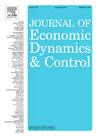Yield curve dynamics and fiscal policy shocks
IF 2.3
3区 经济学
Q2 ECONOMICS
引用次数: 0
Abstract
This paper examines how anticipated, unanticipated, and uncertainty shocks in U.S. government spending affect the term structure of interest rates, showing that fiscal policy design significantly influences the yield curve and financing costs. Combining a recursively-identified fiscal SVAR with an affine term-structure model that incorporates five-year Congressional Budget Office projections and the Economic Policy Uncertainty index, we recover three orthogonal fiscal shocks and trace their effects on bond markets and economic activity. We find that heightened fiscal policy uncertainty induces a flight to quality, causing immediate declines in Treasury yields. Unanticipated spending shocks have a limited impact on yields, underscoring the forward-looking nature of financial markets. Anticipated spending shocks also lower yields as investors adjust expectations about future macroeconomic conditions. Contrary to traditional views, we observe a contractionary effect on real GDP growth, as lower yields reinforce precautionary behavior among households and firms. Our macro-finance framework captures the bidirectional relationship between macroeconomic expectations and financial markets, highlighting the critical role of the yield curve in transmitting fiscal policy shocks to the real economy.
收益率曲线动态与财政政策冲击
本文考察了美国政府支出的预期冲击、非预期冲击和不确定性冲击如何影响利率期限结构,结果表明财政政策设计显著影响收益率曲线和融资成本。将递归识别的财政SVAR与包含五年国会预算办公室预测和经济政策不确定性指数的仿射期限结构模型相结合,我们恢复了三个正交的财政冲击,并追踪了它们对债券市场和经济活动的影响。我们发现,财政政策的不确定性加剧导致投资者向优质资产外逃,从而导致美国国债收益率立即下降。意外支出冲击对收益率的影响有限,突显出金融市场的前瞻性。随着投资者调整对未来宏观经济状况的预期,预期的支出冲击也压低了收益率。与传统观点相反,我们观察到实际GDP增长的收缩效应,因为较低的收益率加强了家庭和企业的预防行为。我们的宏观金融框架抓住了宏观经济预期与金融市场之间的双向关系,强调了收益率曲线在将财政政策冲击传递给实体经济方面的关键作用。
本文章由计算机程序翻译,如有差异,请以英文原文为准。
求助全文
约1分钟内获得全文
求助全文
来源期刊

Journal of Economic Dynamics & Control
ECONOMICS-
CiteScore
3.10
自引率
10.50%
发文量
199
期刊介绍:
The journal provides an outlet for publication of research concerning all theoretical and empirical aspects of economic dynamics and control as well as the development and use of computational methods in economics and finance. Contributions regarding computational methods may include, but are not restricted to, artificial intelligence, databases, decision support systems, genetic algorithms, modelling languages, neural networks, numerical algorithms for optimization, control and equilibria, parallel computing and qualitative reasoning.
 求助内容:
求助内容: 应助结果提醒方式:
应助结果提醒方式:


